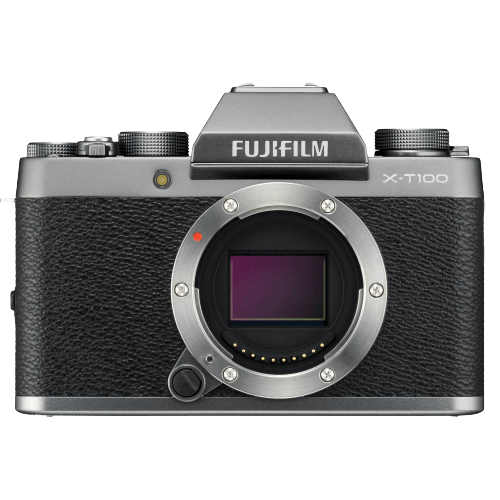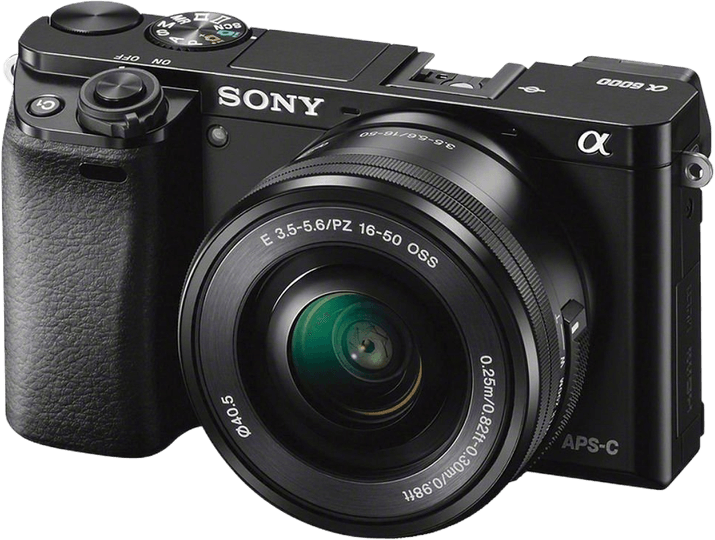Fujifilm X-T100 vs Sony a6000 Comparison
Fujifilm X-T100

Sony a6000

The Fujifilm X-T100 takes the lead with a score of 62/100, outperforming the Sony a6000, which has a score of 57/100. Both cameras are mirrorless and were launched at different times, with the X-T100 being released in 2019 and the a6000 in 2014. They have similar dimensions, but the X-T100 is slightly heavier at 448g compared to the a6000’s 344g.
The X-T100 has the advantage of being a newer model, with a lower launch price of $600 compared to the a6000’s $799. However, the Sony a6000 still holds its ground with its lighter weight, making it more portable and convenient for on-the-go photography.
Taking these factors into account, the Fujifilm X-T100 emerges as the better option due to its more recent release and lower price point, while the Sony a6000 remains a viable choice for those prioritizing a lightweight camera.
Fujifilm X-T100 vs Sony a6000 Overview and Optics
The Sony a6000 outperforms the Fujifilm X-T100 in optics with a score of 67/100 compared to the Fujifilm’s score of 61/100. Both cameras have similarities in their specifications, including 24 megapixels, CMOS sensor type, APS-C sensor size, and no image stabilization. Additionally, they both have their respective lens mounts: Fujifilm X for the X-T100 and Sony E for the a6000.
The Sony a6000 surpasses the Fujifilm X-T100 in several aspects. It has a slightly higher megapixel count at 24.3, leading to marginally better image resolution. The a6000 also boasts a faster shooting speed of 11 frames per second, almost double the X-T100’s 6 frames per second. This allows the Sony a6000 to capture fast-moving subjects more effectively. Furthermore, the a6000’s Bionz X processor and DXOMARK sensor score of 82 contribute to its superior performance in image processing and quality.
On the other hand, the Fujifilm X-T100 holds its own in the optics department, despite scoring lower overall. It shares the same megapixel count, sensor type, and sensor size as the a6000. However, the X-T100 lacks a DXOMARK sensor score, as DXOMARK does not score Fujifilm cameras. This makes it difficult to compare the two cameras’ sensor performance directly.
Taking these factors into account, the Sony a6000 emerges as the superior camera in terms of optics. Its faster shooting speed, better image resolution, and higher DXOMARK sensor score make it a more appealing option for photographers seeking high-quality images. The Fujifilm X-T100, while not far behind, falls short in these areas, making it a less desirable choice when considering optics alone.
Fujifilm X-T100 vs Sony a6000 Video Performance
The Fujifilm X-T100 outperforms the Sony a6000 in video capabilities with a score of 83/100 compared to the a6000’s 56/100. Both cameras share some common features, such as a maximum video frame rate of 60fps. However, the X-T100 surpasses the a6000 in several key areas, making it the superior choice for videographers.
One of the main advantages of the X-T100 is its maximum video resolution, which reaches 4K (3840 x 2160) compared to the a6000’s Full HD (1920 x 1080) resolution. This higher resolution allows for greater detail and clarity, providing a significant improvement in overall video quality. In addition, the Fujifilm X-T100 has built-in time-lapse functionality, while the Sony a6000 does not. This feature enables users to create stunning time-lapse videos without the need for additional software or equipment.
On the other hand, the Sony a6000 does not offer any notable advantages over the Fujifilm X-T100 in terms of video capabilities. Both cameras share the same maximum frame rate of 60fps, but the X-T100’s higher resolution and time-lapse functionality make it the clear winner in this comparison.
Given these factors, it is evident that the Fujifilm X-T100 is the better choice for those seeking a camera with superior video capabilities. Its higher resolution and built-in time-lapse functionality provide users with more creative options and better overall video quality. While the Sony a6000 may be a suitable choice for some, it falls short in this particular aspect when compared to the X-T100.
Fujifilm X-T100 vs Sony a6000 Features and Benefits
The Fujifilm X-T100 outperforms the Sony a6000 in terms of features with a score of 70/100, compared to the Sony a6000’s 41/100. Both cameras share some similarities in specifications, such as a 3-inch screen size, the absence of GPS, and the presence of WIFI connectivity. However, the Fujifilm X-T100 surpasses the Sony a6000 in several aspects, ultimately leading to its higher score.
The Fujifilm X-T100 has a higher screen resolution of 1,040,000 dots, compared to the Sony a6000’s 921,600 dots. This difference in resolution provides a clearer and sharper display on the X-T100. Additionally, the Fujifilm X-T100 has a touchscreen, which the Sony a6000 lacks. This feature allows for easier navigation and control. Furthermore, the X-T100 has Bluetooth connectivity, enabling seamless transfer of files and remote control of the camera, whereas the a6000 does not have this feature.
On the other hand, the Sony a6000 does have a flip screen, just like the Fujifilm X-T100. This feature allows for versatile shooting angles and easy self-portraits. However, this is the only advantage the a6000 shares with the X-T100, as the other features are either inferior or absent in comparison.
Taking these factors into account, the Fujifilm X-T100 is the clear winner in terms of features, offering higher screen resolution, a touchscreen, and Bluetooth connectivity. The Sony a6000 falls short in these aspects, only matching the X-T100 with its flip screen feature. Therefore, the Fujifilm X-T100 proves to be the superior camera in this comparison.
Fujifilm X-T100 vs Sony a6000 Storage and Battery
The Fujifilm X-T100 outperforms the Sony a6000 in storage and battery with a score of 37/100 compared to the a6000’s 21/100. Both cameras have one memory card slot and accept SD, SDHC, and SDXC cards. However, the X-T100 is UHS-I compatible, while the a6000 also accepts Memory Stick Pro Duo and Pro-HG Duo cards.
The X-T100 has a longer battery life, providing 440 shots per charge with its NP-W126s battery, while the a6000 offers 360 shots with its NP-FW50 battery. Additionally, the X-T100 has USB charging capabilities, which the a6000 lacks.
The Sony a6000’s advantage lies in its compatibility with Memory Stick cards, offering users more storage options. However, the Fujifilm X-T100’s longer battery life and USB charging make it the superior choice for storage and battery performance.
Alternatives to the Fujifilm X-T100 and Sony a6000
Are you still undecided about which camera is right for you? Have a look at these popular comparisons that feature the Fujifilm X-T100 or the Sony a6000:

